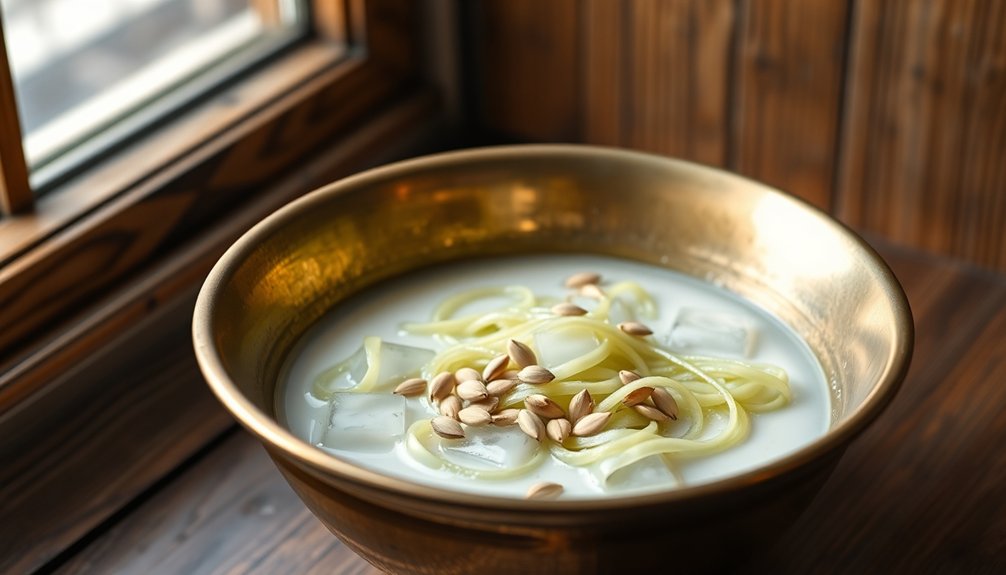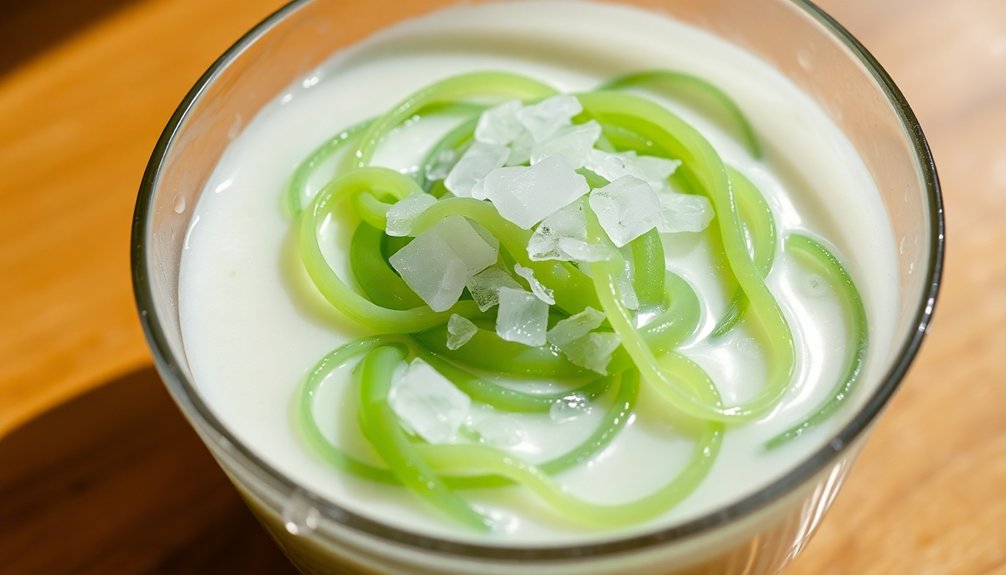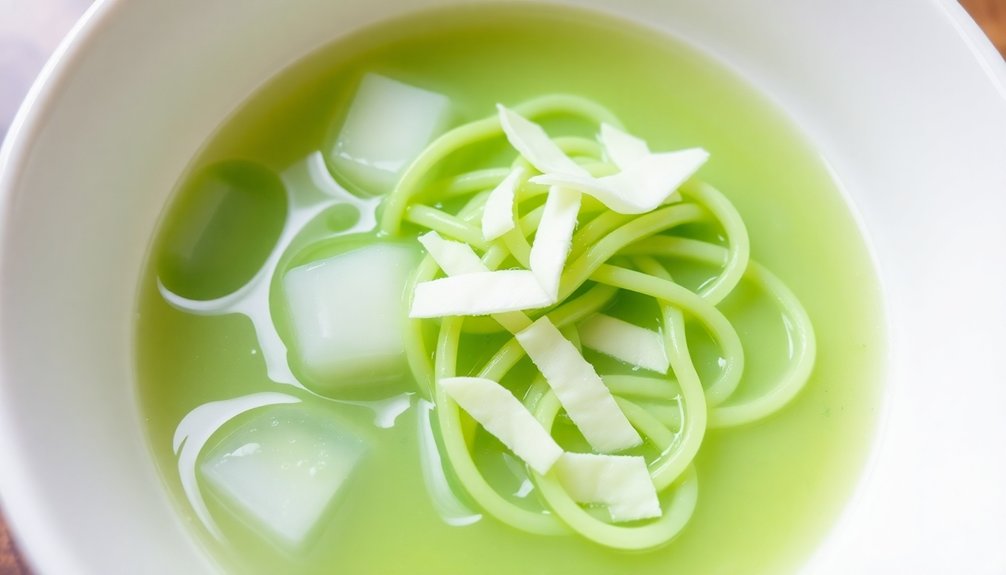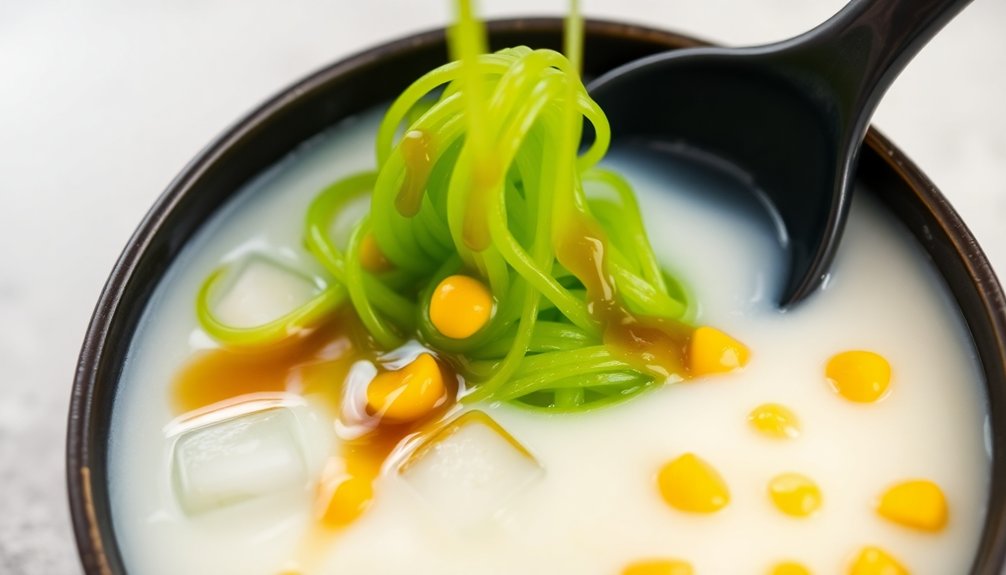Lod Chong - Pandan Rice Noodles in Coconut Milk
You'll discover a centuries-old Thai dessert that combines chewy pandan-flavored rice noodles with sweet coconut milk and crushed ice. The name "Lod Chong" means "falling through," referring to how the green noodles are traditionally made by dripping rice flour mixture into boiling water. This invigorating treat balances earthiness from pandan with creamy coconut sweetness, making it perfect for hot days. Let's explore this beloved dessert's authentic preparation and cultural significance.
Key Takeaways
- Lod Chong is a Thai dessert featuring pandan-flavored rice noodles served in sweetened coconut milk with crushed ice.
- The dish's name means "falling through," referencing the traditional method of drizzling rice flour mixture into boiling water.
- Key ingredients include rice flour, pandan leaves, coconut milk, palm sugar, and salt, creating a balance of sweet and creamy flavors.
- The dessert requires specific preparation steps: soaking rice flour, making pandan noodles, and preparing sweet coconut milk sauce.
- Lod Chong is especially popular during hot summer months and serves as a refreshing treat in Thai culinary culture.
History

Although the exact origins remain unclear, Lod Chong has been a beloved Thai dessert for generations, with roots tracing back to traditional Southeast Asian cooking methods.
You'll find this dessert's cultural significance deeply woven into Thailand's culinary heritage, particularly during hot summer months when it's served as a cooling refreshment.
The pandan-flavored rice noodles have evolved over time, with regional variations emerging throughout Thailand and neighboring countries.
In central Thailand, you'll notice they serve it with coconut milk that's slightly saltier, while southern regions often add palm sugar for extra sweetness.
The dessert's name translates to "falling through," referring to how the rice flour mixture is dripped through a special colander into boiling water, creating its distinctive short, worm-like shapes.
Recipe

Ingredients:
- 200g pandan rice noodles
- 400ml coconut milk
- 200ml water
- 3-4 pandan leaves, tied in knots
- 1/2 cup palm sugar
- 1/4 tsp salt
- Crushed ice for serving
Instructions:
- Soak the rice noodles in room temperature water for 15-20 minutes until soft.
- Drain the noodles and cut them into 2-inch lengths.
- In a pot, combine coconut milk and water.
- Add pandan leaves, palm sugar, and salt.
- Bring the mixture to a gentle simmer over medium heat, stirring occasionally until sugar dissolves.
- Add the rice noodles and cook for 2-3 minutes until tender.
- Remove from heat and discard pandan leaves.
- Let the mixture cool to room temperature.
- Serve in individual bowls with crushed ice on top.
Cooking Steps

You'll begin by soaking Thai rice flour overnight to achieve the proper texture needed for authentic lod chong noodles.
Next, you'll combine fresh coconut milk, palm sugar, and a pinch of salt while preparing a separate mixture of pandan juice and rice flour to create the signature green dough.
Finally, you'll extrude the dough through a traditional rice noodle press into an ice water bath, forming those distinctive short, worm-like strands that give lod chong its name and characteristic chewiness.
Step 1. Soak Rice Flour Overnight
The traditional preparation of Lod Chong begins with soaking rice flour in water overnight, a crucial step that softens the starch granules and guarantees a smooth, elastic texture in the final noodles.
This ancient Thai technique guarantees the rice flour's starch molecules fully hydrate, making the dough more pliable and easier to shape into the characteristic cylindrical noodles.
- Use room temperature water in a 2:1 ratio with rice flour for ideal soaking benefits
- Cover the mixture with a clean cloth to prevent contamination while allowing air circulation
- Place the soaking container in a cool, dark spot to maintain consistent temperature
- Stir once before soaking to verify all rice flour particles are fully submerged
The soaking process transforms ordinary rice flour into a workable paste that's crucial for authentic Lod Chong's distinctive texture and mouthfeel.
Step 2. Mix Coconut Milk Ingredients
While the rice noodles rest, preparing the sweet coconut milk sauce forms the heart of authentic Lod Chong's distinctive flavor profile.
You'll need to combine thick coconut milk with palm sugar, a touch of salt, and a small amount of pandan extract to achieve the traditional taste of this beloved Thai dessert.
Start by warming the coconut milk in a saucepan over medium heat, being careful not to let it boil.
Add palm sugar gradually, stirring until it completely dissolves. The flavor balance between sweet and creamy is essential - you want the sauce rich but not overwhelmingly sweet.
Add just a pinch of salt to enhance the overall taste, then finish with a few drops of pandan extract for that signature aroma.
Let the mixture cool to room temperature before serving.
Step 3. Create Pandan Noodle Dough
Preparing authentic Lod Chong noodle dough starts with combining rice flour, tapioca starch, and fresh pandan juice extracted from pandan leaves.
This traditional Thai dessert relies on the perfect balance of ingredients to achieve its signature pandan flavor and chewy noodle texture.
You'll need to carefully measure and mix these components until you've created a smooth, lump-free batter with the right consistency.
- Mix rice flour and tapioca starch in a large bowl, ensuring even distribution.
- Gradually pour in fresh pandan juice while stirring continuously to prevent lumps.
- Strain the mixture through a fine-mesh sieve to remove any remaining clumps.
- Let the dough rest for 15 minutes to allow the starches to fully hydrate and develop proper elasticity.
Step 4. Prepare Ice Water Bath
With your pandan noodle dough ready, you'll need to set up an ice water bath - a key element in traditional Lod Chong preparation that Thai cooks have used for generations.
Fill a large bowl with cold water and add enough ice cubes to maintain a temperature just above freezing. This cooling process is vital for setting the rice noodles properly and achieving their characteristic chewy texture.
Make certain your ice bath is deep enough to accommodate the noodles as they fall from the mold. Thai cooks traditionally use at least 4-5 inches of water depth to guarantee the noodles don't clump together.
The ice-cold temperature immediately firms up the noodles, preserving their cylindrical shape and vibrant green color while stopping any further cooking.
Step 5. Shape Noodles Into Strands
Pour your prepared pandan rice dough into a traditional Lod Chong mold or potato ricer, holding it about 2-3 inches above the ice bath. This ancient Thai noodle-making technique creates distinctive short, cylindrical strands that are essential to authentic Lod Chong.
You'll need to apply steady, even pressure as you squeeze the dough through the mold's tiny holes.
- Squeeze with consistent pressure to guarantee uniform noodle shapes and prevent broken strands
- Let the strands drop directly into the ice water - they'll firm up immediately on contact
- Work in small batches to prevent overcrowding and noodle clumping
- Check that each strand has a smooth surface and clean-cut ends, a sign of proper noodle techniques
These green droplets transform into chewy, translucent noodles that carry centuries of Thai culinary tradition.
Cooking Tips

To achieve the perfect lod chong, you'll need to master a few essential techniques that Thai cooks have refined over generations.
Start by ensuring your rice flour mixture isn't too thick or thin - it should drip steadily like honey from your spoon. When you're dropping the noodles into ice water, maintain consistent pressure for uniform strands.
If you can't find pandan leaves, you can substitute with pandan extract, though the authentic aroma won't be quite the same.
The coconut milk should be fresh and full-fat for the best results. Don't skip the ice bath step - it's vital for achieving that signature chewy texture.
Keep the cooking temperature moderate, as high heat can make the noodles too soft and lose their characteristic springiness.
Final Thoughts

Although mastering lod chong requires patience and attention to detail, the resulting dessert offers a uniquely Thai experience that's well worth the effort.
This beloved dessert connects you to Thailand's rich culinary heritage while providing numerous benefits, from the antioxidant properties of pandan to the cooling effects perfect for tropical climates.
- You'll discover the cultural significance of how this dessert brings families together during traditional celebrations and festivals.
- You're participating in a centuries-old Thai culinary tradition that showcases the artful balance of textures and flavors.
- You'll experience the authentic combination of pandan's earthiness with coconut milk's creamy sweetness.
- You're treating yourself to a dessert that's not just invigorating but also carries the nutritional benefits of natural ingredients.
Frequently Asked Questions
Can Lod Chong Be Made Ahead and Stored in the Refrigerator?
You can store prepared lod chong noodles in the fridge for up to 3 days. Keep them in cold water, but store the coconut milk separately until you're ready to serve.
Why Does My Lod Chong Noodles Sometimes Sink Instead of Float?
Like little divers in your bowl, your lod chong noodles sink when their texture's too dense. You'll get floating noodles by making sure you're using the right rice flour-to-water ratio.
Is There a Substitute for Pandan Leaves in This Dessert?
You can use pandan extract as the closest substitute, but vanilla extract mixed with a touch of matcha or screwpine essence will provide similar flavor alternatives for your dessert.
What Causes Lod Chong Noodles to Become Too Chewy or Rubbery?
If you've got chewy texture or rubbery consistency in your noodles, you're likely using too much tapioca flour or cooking them too long after they've set. Watch your ratios carefully.
Can I Use Regular Sugar Instead of Palm Sugar?
You'll miss the authentic melodies of Southeast Asian flavors if you skip palm sugar. While regular sugar works, palm sugar benefits include caramel notes and deeper sweetness that other sugar alternatives can't match.
